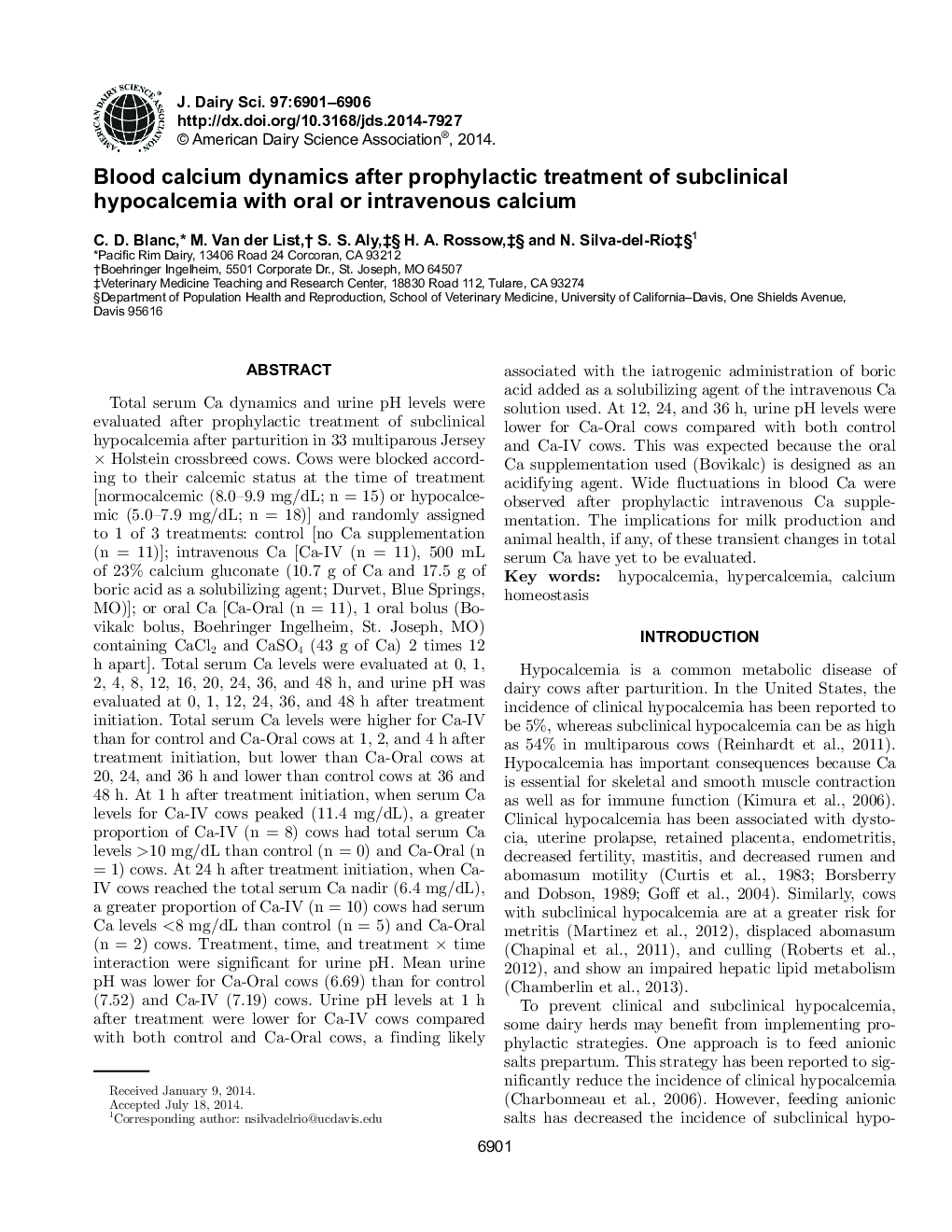| Article ID | Journal | Published Year | Pages | File Type |
|---|---|---|---|---|
| 10976890 | Journal of Dairy Science | 2014 | 6 Pages |
Abstract
Total serum Ca dynamics and urine pH levels were evaluated after prophylactic treatment of subclinical hypocalcemia after parturition in 33 multiparous Jersey à Holstein crossbreed cows. Cows were blocked according to their calcemic status at the time of treatment [normocalcemic (8.0-9.9 mg/dL; n = 15) or hypocalcemic (5.0-7.9 mg/dL; n = 18)] and randomly assigned to 1 of 3 treatments: control [no Ca supplementation (n = 11)]; intravenous Ca [Ca-IV (n = 11), 500 mL of 23% calcium gluconate (10.7 g of Ca and 17.5 g of boric acid as a solubilizing agent; Durvet, Blue Springs, MO)]; or oral Ca [Ca-Oral (n = 11), 1 oral bolus (Bovikalc bolus, Boehringer Ingelheim, St. Joseph, MO) containing CaCl2 and CaSO4 (43 g of Ca) 2 times 12 h apart]. Total serum Ca levels were evaluated at 0, 1, 2, 4, 8, 12, 16, 20, 24, 36, and 48 h, and urine pH was evaluated at 0, 1, 12, 24, 36, and 48 h after treatment initiation. Total serum Ca levels were higher for Ca-IV than for control and Ca-Oral cows at 1, 2, and 4 h after treatment initiation, but lower than Ca-Oral cows at 20, 24, and 36 h and lower than control cows at 36 and 48 h. At 1 h after treatment initiation, when serum Ca levels for Ca-IV cows peaked (11.4 mg/dL), a greater proportion of Ca-IV (n = 8) cows had total serum Ca levels >10 mg/dL than control (n = 0) and Ca-Oral (n = 1) cows. At 24 h after treatment initiation, when Ca-IV cows reached the total serum Ca nadir (6.4 mg/dL), a greater proportion of Ca-IV (n = 10) cows had serum Ca levels <8 mg/dL than control (n = 5) and Ca-Oral (n = 2) cows. Treatment, time, and treatment à time interaction were significant for urine pH. Mean urine pH was lower for Ca-Oral cows (6.69) than for control (7.52) and Ca-IV (7.19) cows. Urine pH levels at 1 h after treatment were lower for Ca-IV cows compared with both control and Ca-Oral cows, a finding likely associated with the iatrogenic administration of boric acid added as a solubilizing agent of the intravenous Ca solution used. At 12, 24, and 36 h, urine pH levels were lower for Ca-Oral cows compared with both control and Ca-IV cows. This was expected because the oral Ca supplementation used (Bovikalc) is designed as an acidifying agent. Wide fluctuations in blood Ca were observed after prophylactic intravenous Ca supplementation. The implications for milk production and animal health, if any, of these transient changes in total serum Ca have yet to be evaluated.
Related Topics
Life Sciences
Agricultural and Biological Sciences
Animal Science and Zoology
Authors
C.D. Blanc, M. Van der List, S.S. Aly, H.A. Rossow, N. Silva-del-RÃo,
